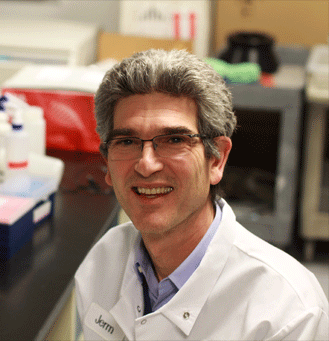 |
|
|
Heinrich Gottlinger, MD, PhD |
|
 |
|
|
Jeremy Luban, MD |
A pair of studies in the journal Nature, one by Jeremy Luban, MD, and colleagues in Italy and Switzerland, and the other by Heinrich Gottlinger, MD, PhD, and colleagues; have identified genes that disable HIV-1, suggesting a promising new strategy for battling the virus that causes AIDS.
The studies, published online Sept. 30, show that the host cell membrane proteins SERINC5 and SERINC3 greatly reduce the virulence of HIV-1 by blocking the ability of the virus to infect new cells. HIV-1 encodes a protein called Nef that counteracts the SERINCs. New drugs that target the HIV-1 protein Nef would permit the SERINC proteins to inactivate the virus. The papers will appear in the Oct. 8 Nature print edition.
“It’s amazing, the magnitude of the effect that these proteins have on infectivity,” said Dr. Luban, the David J. Freelander Professor in AIDS Research and professor of molecular medicine. “The SERINC proteins reduce the infectivity of HIV-1 virions by more than 100-fold.”
Dr. Gottlinger, professor of molecular, cell & cancer biology and principal investigator of one of the studies, said, “The ability of HIV to inhibit these SERINC proteins has a profound impact on its capacity to infect other cells. Disrupting this mechanism could be a very powerful strategy for treating HIV and similar viruses that express the Nef protein.”
The studies, each done independently, used different, yet complementary, methodologies to unravel the complex interaction between the HIV-1 protein Nef and the cell surface membrane proteins SERINC5 and SERINC3, both of which are expressed in the immune system’s T cells. Luban, working with former members of his lab Massimo Pizzato, PhD, now of the University of Trento in Italy, and Federico Santoni of the University of Geneva in Switzerland, performed massively parallel sequencing on 31 human cell lines that differed in terms of the magnitude of dependence on Nef for HIV-1 replication. Independently, Gottlinger approached the problem biochemically. Conducting proteomic analysis of purified virions, he was able to identify host cell proteins that Nef regulated.
“It has been known for more than 20 years that Nef is needed to make HIV-1 such a deadly virus,” said Luban. “Our new studies may finally give us an important glimpse into how Nef might do this.”
Viruses are relatively simple agents that lack the machinery needed to reproduce on their own. The HIV-1 virus, for example, consists of only nine genes. To replicate its genome, HIV-1 requires a host cell. Once the virus has infected a cell, it takes over certain native cellular processes so that it can replicate. Ultimately, the infected host cell produces new virions carrying the HIV-1 genome. These virions, in turn, search for new cells to infect, continuing the cycle of infection.
Nef, one of nine primary proteins expressed by HIV, induces numerous changes in the host cell that increase the virus’s ability to infect new cells. One of its jobs, according to the findings of Luban, Gottlinger, and colleagues, is to sequester SERINC3 and SERINC5 so that these cellular proteins do not reach the surface of the cell and cannot be incorporated into newly formed virions. In the absence of Nef, upon leaving the cell, virions incorporate the SERINC3 and SERINC5 proteins into the viral envelope and are rendered unable to infect new target cells.
“These virions are able to latch onto potential host cells,” said Gottlinger, “but the HIV-1 genome can’t pass through the viral envelope when SERINC3 and SERINC5 are present. Somehow these proteins are blocking the release of the virus’s genome, essentially keeping the virus from spreading.”
Isolating the SERINC proteins biochemically was particularly challenging, explained Gottlinger. “The SERINC proteins are hard to detect under standard experimental conditions because they tend to aggregate at any temperature above 37 C,” he said. “To get around this problem, we had to devise a way to run the experiment below a set temperature so the protein would remain soluble.”
Both groups also ran the same experiments, with similar results, using the structurally unrelated murine leukemia virus (MLV) protein known as glycoGag, which is known to substitute functionally for the Nef protein. These findings demonstrate that the SERINC proteins probably inhibit the infectivity of all retroviruses, even those most distantly related to HIV-1.
“The anti-retroviral effect of SERINC therefore seems to extend across all retroviruses and may turn out to be universal,” said Luban. “Our findings could have implications for treating all enveloped viruses.”
The next step for Luban and Gottlinger is to determine precisely how the SERINC proteins are blocking the virions from downloading its genome into new host cells. “One possibility is that SERINC is physically keeping the virus’s genome from passing through the viral envelope and the cellular membrane into the new host cell,” said Luban. “There’s still much that we don’t know about this process and how SERINC works.”
Read the papers here:
Luban: http://dx.doi.org/10.1038/nature15399
Gottlinger: http://dx.doi.org/10.1038/nature15400